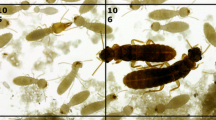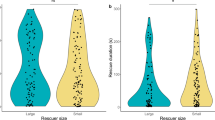Summary
Caste-specific division of labour can be observed in extranidal activities inMacrotermes bellicosus. Food is acquired through a sequence of tasks shared between the two worker castes. During the exploration phase, a network of subterranean galleries is built outwards from the nest, almost exclusively by minor workers. The frequency of excursions made by major workers during this building period is low, but increases significantly when food is needed by the colony. After a food-source has been discovered, it is hardly exploited by the minor workers and no recruitment occurs. They continue to construct galleries, while individuals which have contact with the food show local fidelity in their building activities within the gallery nearest to the food. After a single sporadic major worker accidentally comes across a food-source, the ratio of major to minor workers continually increases. New major workers aim for the food, bite off pieces and may transfer them to the minor workers. In general, only major workers are recruited after food has been discovered, and they then orientate towards the food-source more distinctly than the minor workers.
Similar content being viewed by others
References
Badertscher, S., C. Gerber and R. H. Leuthold, 1983. Polyethism in food supply and processing in termite colonies ofMacrotermes subhyalinus (Isoptera).Behav. Ecol. Sociobiol. 12:115–119.
Collins, N. M., 1977.The population ecology and energetics of Macrotermes bellicosus (Smeathman, Isoptera). Unpublished thesis, University of London.
Collins, N. M., 1981a. Populations, age-structure and survivorship of colonies ofMacrotermes bellicosus (Isoptera; Macrotermitinae).J. Anim. Ecol. 50:293–311.
Collins, N. M., 1981b. The role of termites in the decomposition of wood and leaf litter in the southern savanna of Nigeria.Oecologia 51:389–399.
Darlington, J. P. E. C., 1984. A method for sampling the population of large termite nests.Ann. Appl. Biol. 104:427–436.
Garnier-Sillam, E., 1983. Le polyéthisme chezReticulitermes santonensis.Ins. Soc. 30:27–44.
Gerber, C., 1986.Bedeutung der Termite Macrotermes bellicosus (Smeathman) beim Abbau von totem pflanzlichem Material in Kokosplantagen: Einfluss auf das Ökosystem und kolonieinterne Organisation. Unpublished thesis, University of Berne.
Gerber, C., S. Badertscher and R. H. Leuthold, 1988. Polyethism inMacrotermes bellicosus.Ins. Soc. 35:226–240.
Jones, S. C., J. P. Lafage and R. W. Howard, 1988. Isopteran sex ratios: phylogenetic trends.Sociobiology 14:89–156.
Lepage, M. G., 1977. Foraging and food consumption ofMacrotermes subhyalinus.Proc. Int. Congr. IUSSI 8:249–252.
Lepage, M. G., 1981. L'impact des populations récoltantes deMacrotermes michaelseni (Sjöstedt) dans un écosystème semi-aride (Kajiado, Kenya). I. L'activité de récolte et son déterminisme.Ins. Soc. 28:297–308.
Lepage, M. G., 1983. Foraging ofMacrotermes spp. (Isoptera; Macrotermitinae) in the tropics.Soc. Ins. Trop. 2:205–218.
Lys, J. A. and R. H. Leuthold, 1991. Morphology of the gallery system around the nest and gallery development under experimental conditions in the termiteMacrotermes bellicosus (Smeathman).Ins. Soc. 38:63–76.
McMahan, E., 1970. Polyethism in workers ofNasutitermes costalis.Ins. Soc. 7:113–120.
McMahan, E., 1977. Mound repair and foraging polyethism in workers ofNasutitermes exitosus.Ins. Soc. 24:225–232.
McMahan, E., 1979. Temporal polyethism in termites.Sociobiology 4:153–168.
McMahan, E. and J. A. L. Watson, 1977. The effect of separation by “papering” on caste ratios inNasutitermes exitosus.J. Austr. Ent. Soc. 16:455–457.
Noirot, C., 1969. Formation of castes in higher termites. In:Biology of Termites vol. I (Krishna and Weesner, Eds.), Academic Press, New York, pp. 311–350.
Oster, G. F. and E. O. Wilson, 1978.Caste and Ecology in the Social Insects. Princeton University Press, Princeton, pp. 352.
Pasteels, J. M., 1965. Polyéthisme chez les ouvriers deNasutitermes lujae lors de l'établissement d'une piste de récolte.J. Biol. Gabon 1:191–205.
Schedel, A. and M. Kaib, 1987. Polyethism during foraging inSchedorhinotermes lamanianus in unprotected areas: The role of exocrine glands. In:Chemistry and Biology of Social Insects (Eder and Rembold, Eds.), Peperny, Munich, p. 416.
Traniello, J. F. A. and C. Busher, 1985. Chemical regulation of polyethism during foraging in the neotropical termiteNasutitermes costalis.J. Chem. Ecol. 11:319–322.
Wilson, E. O., 1971.The Insect Societies. The Belknap Press, Cambridge, USA, pp. 548.
Author information
Authors and Affiliations
Rights and permissions
About this article
Cite this article
Lys, J.A., Leuthold, R.H. Task-specific distribution of the two worker castes in extranidal activities inMacrotermes bellicosus (Smeathman): Observation of behaviour during food acquisition. Ins. Soc 38, 161–170 (1991). https://doi.org/10.1007/BF01240966
Received:
Accepted:
Issue Date:
DOI: https://doi.org/10.1007/BF01240966




